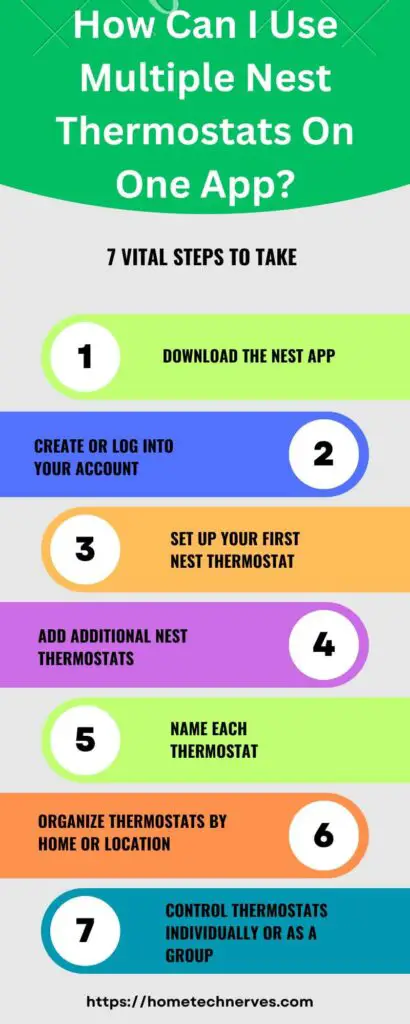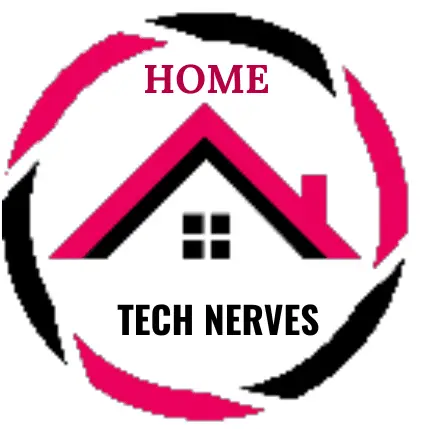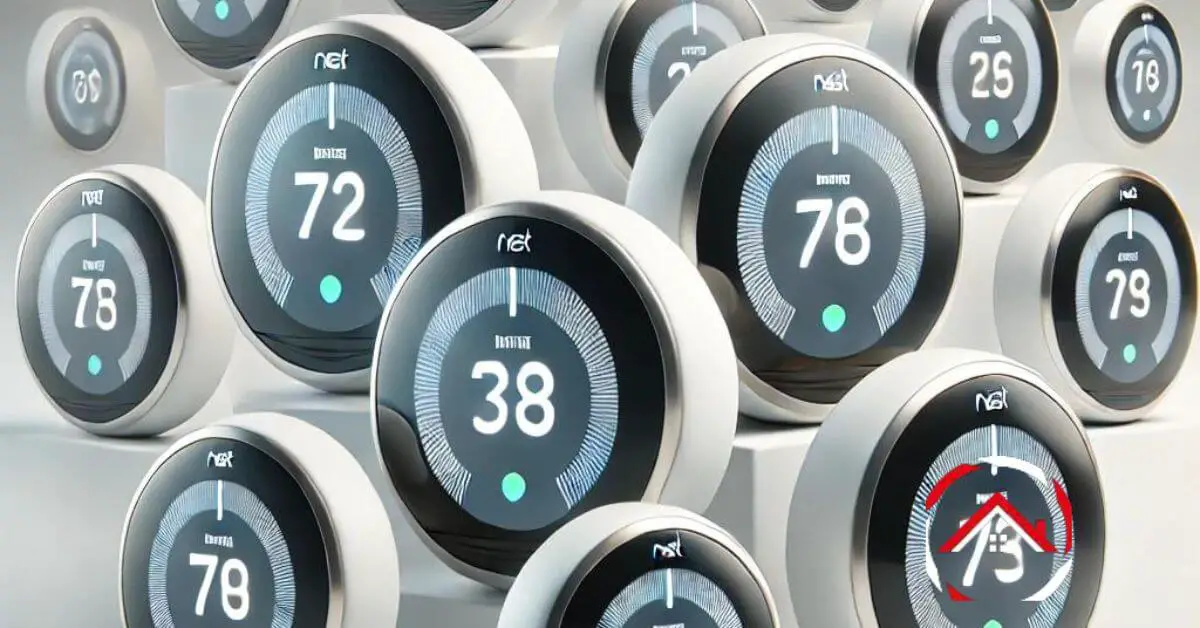Nest thermostats are changing how we control our homes’ temperatures. They’re smart, sleek, and easy to use. Imagine having a device that learns your habits and adjusts itself.
Multiple Nest thermostats can make this even better. With more than one, you can manage different areas of your home more precisely.
Each thermostat can be set up for specific rooms, saving energy and keeping everyone comfortable.
Plus, you can control them all from your phone. It’s like having a personal climate expert right at your fingertips. Isn’t that cool?
Let’s dive into how these devices can transform your home.
Table of Contents
Can I Use Multiple Nest Thermostats On One App?
Managing your home’s temperature has never been easier, thanks to Nest thermostats. But what if you have more than one? You might be wondering how to control multiple Nest thermostats efficiently.
The good news is, you can manage all your thermostats from a single app. Let’s explore how to set it up and make the most of your smart home system.
Setting Up Multiple Thermostats
To get started, you’ll need to install each Nest thermostat in the desired location. Ensure they’re all connected to your home Wi-Fi network.
Follow the setup instructions in the Nest app to add each thermostat. Once they’re added, you can manage them all from the same app.
Managing Multiple Thermostats in the App
Once your thermostats are set up, open the Nest app. You’ll see all your thermostats listed on the main screen.
From here, you can adjust settings, create schedules, and monitor energy usage for each one individually. The app provides a simple interface for managing multiple devices at once.
Creating Custom Schedules
With multiple Nest thermostats, you can create custom schedules for each thermostat. This is useful for optimizing comfort and efficiency in different areas of your home.
For example, you might want a different temperature in the living room compared to the bedrooms. The app allows you to set and adjust these schedules easily.
Monitoring Energy Usage
The Nest app provides detailed reports on energy usage for each thermostat. This helps you understand how much energy each area of your home is consuming. You can use this information to make adjustments and save on your energy bills.
Troubleshooting Common Issues
If you encounter any issues with managing multiple thermostats, check your Wi-Fi connection and ensure all thermostats are properly connected to the app.
The app also has a troubleshooting guide that can help resolve common problems. For persistent issues, Nest support is available to assist you.

Do I Need 2 Nest Thermostats For 2 Zones?
When managing different zones in your home, you might wonder if you need separate Nest thermostats for each one. The answer often depends on how your home’s heating and cooling systems are set up.
Let’s explore whether having two Nest thermostats is necessary for managing two distinct zones effectively.
Understanding Zones in Your Home
A zone in a home refers to a distinct area that requires separate temperature control. This often means having separate heating or cooling systems for different parts of the house.
Understanding your home’s zoning setup is crucial before deciding if you need multiple thermostats.
Benefits of Using Two Thermostats
Having two Nest thermostats allows you to control each zone independently. This means you can set different temperatures for different areas of your home, enhancing comfort and efficiency.
For example, you might prefer a cooler temperature in the bedroom and a warmer setting in the living room.
Compatibility with Existing Systems
Before installing two thermostats, check if your current heating and cooling systems support zoning. Some systems are designed to work with multiple thermostats, while others may not be compatible.
Consulting with a professional can help determine if your setup can accommodate two Nest thermostats.
Installation and Setup
Installing two Nest thermostats involves placing one in each zone and ensuring they are properly connected to your home’s HVAC system.
Follow the installation instructions for each thermostat, and use the Nest app to configure them for separate zones. Proper setup is key to effective temperature management.
Alternative Solutions
If your system does not support multiple thermostats, consider alternative solutions like smart zone controllers or dampers.
These options can help manage different zones without the need for two separate thermostats. A professional can guide you in choosing the best solution for your home’s needs.
Can 2 Thermostats Control 1 Zone?
Yes, two thermostats can control one zone, but it’s not always ideal. Here’s why:
Potential Benefits
Having two thermostats in one zone can offer more precise control if the area is large or has varying heating/cooling needs. For example, if you have a large open space, placing thermostats in different locations can help balance the temperature more effectively.
Installation Considerations
When using two thermostats for one zone, both need to be properly wired to the same HVAC system.
They should be set to the same temperature to avoid conflicts. If they are not synchronized, one thermostat could override the settings of the other, leading to inconsistent temperatures.
System Compatibility
Not all HVAC systems are designed to handle multiple thermostats for a single zone. Check your system’s compatibility with this setup.
In some cases, a single thermostat with a remote sensor might be a better option for managing temperature across a large space.
Practical Challenges
Managing two thermostats for one zone can be complex. If the thermostats are not correctly set up, you might experience issues like conflicting temperature settings or inefficient operation.
It’s crucial to ensure that both thermostats are calibrated and functioning correctly.
Alternative Solutions
Consider using a single thermostat with additional remote sensors. Many modern smart thermostats offer this feature, allowing you to monitor and adjust temperature from different locations without the complications of multiple thermostats. This setup can simplify management and enhance comfort.
What is Nest Learning Thermostat?
The Nest Learning Thermostat is a smart thermostat designed to optimize your home’s heating and cooling systems. Here’s a quick overview:
What It Does
The Nest Learning Thermostat learns your temperature preferences over time and automatically adjusts settings to match. It adapts to your routines, making energy-saving adjustments when you’re away and ensuring comfort when you’re home.
Key Features
- Learning Capability: It tracks your adjustments and learns your schedule, eventually setting temperatures based on your preferences without manual input.
- Remote Control: You can control it from anywhere using the Nest app on your smartphone. This allows you to adjust temperatures, set schedules, and monitor energy usage even when you’re not at home.
- Energy Saving: The thermostat provides energy usage reports and suggests ways to save on your energy bills. It can also use weather data and occupancy sensors to optimize heating and cooling.
- Integration: It works with other smart home devices and systems, such as voice assistants like Google Assistant and Amazon Alexa, for voice control and integration into your smart home ecosystem.
- Design: It features a sleek, modern design with a high-resolution display that shows the temperature and other relevant information clearly.
Overall, the Nest Learning Thermostat aims to make managing your home’s temperature easier, more efficient, and more energy-saving.
How To Install Nest Thermostat Dual Zone
Installing a Nest thermostat in a dual-zone system can seem complex, but with the right steps, it’s manageable. Follow this guide to ensure a smooth setup and optimize your home’s temperature control.
1. Turn Off Power
Switch off the power to your HVAC system at the breaker box to ensure safety during installation.
2. Remove Old Thermostat
Detach the existing thermostat from the wall and label the wires for easier connection later.
3. Connect Wires to Nest Base
Attach the labeled wires to the corresponding terminals on the Nest base. Ensure each wire is securely connected.
4. Mount the Nest Thermostat
Fix the Nest base to the wall, ensuring it’s level and aligned with your existing wiring.
5. Configure Dual Zones
Use the Nest app to set up and configure each thermostat for its respective zone. Follow the app instructions to complete the setup and connect both thermostats to your Wi-Fi network.
Can You Use Two Nest Thermostats on One Heat Link?
No, you cannot use two Nest thermostats on one Heat Link. The Heat Link is designed to work with a single Nest thermostat to control your heating system. Here’s why:
Single Connection
The Heat Link connects to one Nest thermostat, allowing it to control the heating system effectively. It acts as a bridge between the thermostat and the heating system.
Multiple Thermostats Requirement
If you have multiple zones and need more than one thermostat, each thermostat will require its own Heat Link to operate independently. This ensures proper control and avoids conflicts between the thermostats.
Alternative Solutions
For managing multiple zones, consider using separate Heat Links for each thermostat or exploring multi-zone systems designed to handle multiple thermostats efficiently. Consulting with a professional can help determine the best setup for your needs.
Wrap Up
Multiple Nest thermostats can truly enhance your home’s comfort and efficiency. They allow you to tailor temperatures for different rooms or zones, making each area more enjoyable.
By managing them through a single app, you get easy control and can monitor your energy usage effortlessly. Plus, you can create custom schedules for each thermostat, which helps in saving energy and reducing costs.
If you’re considering a smart upgrade, adding multiple Nest thermostats might be the perfect solution.
It’s a simple way to boost comfort and stay energy-efficient. Ready to make the switch? It’s time to enjoy a smarter, cozier home.
Frequently Asked Questions
Can I have multiple Nest thermostats in my home?
Yes, you can have multiple Nest thermostats in your home. Each thermostat controls a specific zone or area, allowing you to manage temperatures individually. This setup helps optimize comfort and energy efficiency across different parts of your house.
How do multiple Nest thermostats work together?
Multiple Nest thermostats work together by independently controlling different zones in your home. They communicate via Wi-Fi, allowing you to adjust each thermostat separately or through the Nest app. This zoned control helps maintain consistent temperatures and improves overall energy efficiency.
Do I need a Nest thermostat in every room?
No, you don’t need a Nest thermostat in every room. Generally, one thermostat per heating or cooling zone is sufficient. However, placing them strategically in key areas ensures better temperature control and energy management across your home.
Can multiple Nest thermostats be controlled by one app?
Yes, you can control multiple Nest thermostats using a single app. The Nest app allows you to manage each thermostat individually or as a group. This central control makes it easy to adjust temperatures and monitor energy usage from anywhere, ensuring convenience and efficiency.
References:
Support.Google.Com. Using multiple Nest thermostats in the same home. https://support.google.com/googlenest/answer/9254411?hl=en



Pretty great post. I just stumbled upon your weblog and wanted to say that I have really loved browsing your weblog posts. After all I’ll be subscribing on your feed and I hope you write once more very soon!
Thank You!